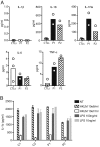Homozygous NLRP1 gain-of-function mutation in siblings with a syndromic form of recurrent respiratory papillomatosis
- PMID: 31484767
- PMCID: PMC6754618
- DOI: 10.1073/pnas.1906184116
Homozygous NLRP1 gain-of-function mutation in siblings with a syndromic form of recurrent respiratory papillomatosis
Abstract
Juvenile-onset recurrent respiratory papillomatosis (JRRP) is a rare and debilitating childhood disease that presents with recurrent growth of papillomas in the upper airway. Two common human papillomaviruses (HPVs), HPV-6 and -11, are implicated in most cases, but it is still not understood why only a small proportion of children develop JRRP following exposure to these common viruses. We report 2 siblings with a syndromic form of JRRP associated with mild dermatologic abnormalities. Whole-exome sequencing of the patients revealed a private homozygous mutation in NLRP1, encoding Nucleotide-Binding Domain Leucine-Rich Repeat Family Pyrin Domain-Containing 1. We find the NLRP1 mutant allele to be gain of function (GOF) for inflammasome activation, as demonstrated by the induction of inflammasome complex oligomerization and IL-1β secretion in an overexpression system. Moreover, patient-derived keratinocytes secrete elevated levels of IL-1β at baseline. Finally, both patients displayed elevated levels of inflammasome-induced cytokines in the serum. Six NLRP1 GOF mutations have previously been described to underlie 3 allelic Mendelian diseases with differing phenotypes and modes of inheritance. Our results demonstrate that an autosomal recessive, syndromic form of JRRP can be associated with an NLRP1 GOF mutation.
Keywords: NLRP1; genetics; human papillomavirus; inflammasome; recurrent respiratory papillomatosis.
Conflict of interest statement
The authors declare no conflict of interest.
Figures




Similar articles
-
The NLRP1 Inflammasome in Human Skin and Beyond.Int J Mol Sci. 2020 Jul 6;21(13):4788. doi: 10.3390/ijms21134788. Int J Mol Sci. 2020. PMID: 32640751 Free PMC article. Review.
-
Autoinflammatory disease with corneal and mucosal dyskeratosis caused by a novel NLRP1 variant.Rheumatology (Oxford). 2020 Sep 1;59(9):2334-2339. doi: 10.1093/rheumatology/kez612. Rheumatology (Oxford). 2020. PMID: 31873740
-
Germline NLRP1 Mutations Cause Skin Inflammatory and Cancer Susceptibility Syndromes via Inflammasome Activation.Cell. 2016 Sep 22;167(1):187-202.e17. doi: 10.1016/j.cell.2016.09.001. Cell. 2016. PMID: 27662089
-
A homozygous p.Leu813Pro gain-of-function NLRP1 variant causes phenotypes of different severity in two siblings.Br J Dermatol. 2023 Feb 10;188(2):259-267. doi: 10.1093/bjd/ljac039. Br J Dermatol. 2023. PMID: 36763876
-
The NLRP1 inflammasomes.Immunol Rev. 2015 May;265(1):22-34. doi: 10.1111/imr.12283. Immunol Rev. 2015. PMID: 25879281 Review.
Cited by
-
The role of host genetics in susceptibility to severe viral infections in humans and insights into host genetics of severe COVID-19: A systematic review.Virus Res. 2020 Nov;289:198163. doi: 10.1016/j.virusres.2020.198163. Epub 2020 Sep 9. Virus Res. 2020. PMID: 32918943 Free PMC article.
-
Immunogenetics of the Ocular Anterior Segment: Lessons from Inherited Disorders.J Ophthalmol. 2021 Jun 28;2021:6691291. doi: 10.1155/2021/6691291. eCollection 2021. J Ophthalmol. 2021. PMID: 34258050 Free PMC article. Review.
-
The NLR family of innate immune and cell death sensors.Immunity. 2024 Apr 9;57(4):674-699. doi: 10.1016/j.immuni.2024.03.012. Immunity. 2024. PMID: 38599165 Free PMC article. Review.
-
A novel dual NLRP1 and NLRP3 inflammasome inhibitor for the treatment of inflammatory diseases.Clin Transl Immunology. 2023 Jun 22;12(6):e1455. doi: 10.1002/cti2.1455. eCollection 2023. Clin Transl Immunology. 2023. PMID: 37360982 Free PMC article.
-
Multiple ASC-dependent inflammasomes drive differential pro-inflammatory cytokine production in a mouse model of tendinopathy.Biosci Rep. 2024 Nov 27;44(11):BSR20241282. doi: 10.1042/BSR20241282. Biosci Rep. 2024. PMID: 39468985 Free PMC article.
References
-
- Marsico M., Mehta V., Chastek B., Liaw K.-L., Derkay C., Estimating the incidence and prevalence of juvenile-onset recurrent respiratory papillomatosis in publicly and privately insured claims databases in the United States. Sex. Transm. Dis. 41, 300–305 (2014). - PubMed
-
- Derkay C. S., Task force on recurrent respiratory papillomas: A preliminary report. Arch. Otolaryngol. Head Neck Surg. 121, 1386–1391 (1995). - PubMed
-
- Larson D. A., Derkay C. S., Epidemiology of recurrent respiratory papillomatosis. APMIS 118, 450–454 (2010). - PubMed
-
- Armstrong L. R., Derkay C. S., Reeves W. C., Initial results from the national registry for juvenile-onset recurrent respiratory papillomatosis. RRP Task Force. Arch. Otolaryngol. Head Neck Surg. 125, 743–748 (1999). - PubMed
Publication types
MeSH terms
Substances
Supplementary concepts
Grants and funding
LinkOut - more resources
Full Text Sources
Other Literature Sources
Molecular Biology Databases

